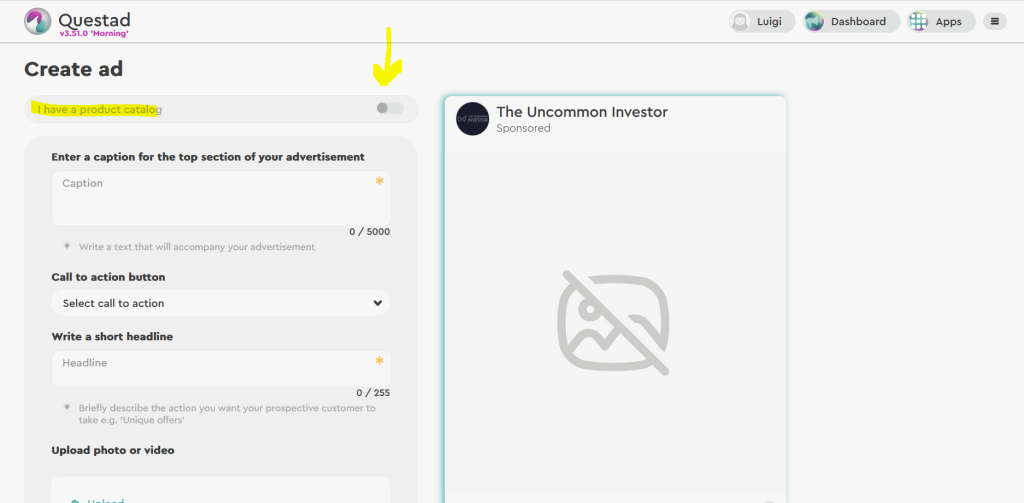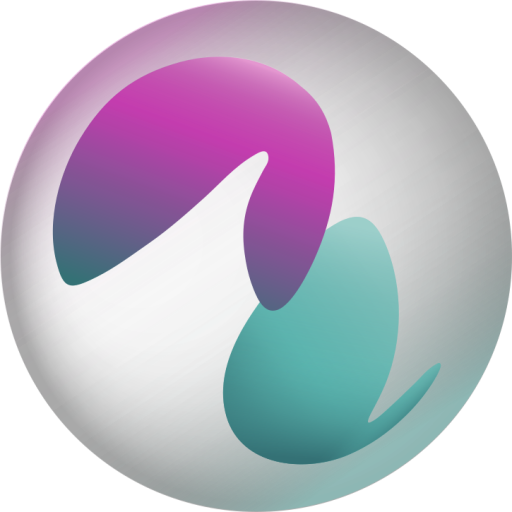The following article is a complete guide for a professional or small business owner to run ads as efficiently as possible on META’s network, specifically Facebook & Instagram. It is emphasized that no special digital marketing knowledge is required, as the https://questad.doitforme.eu tool guides us step-by-step in avoiding mistakes and maximizing results by automating the ad management process.
Step 1: Choose whether you offer services or products
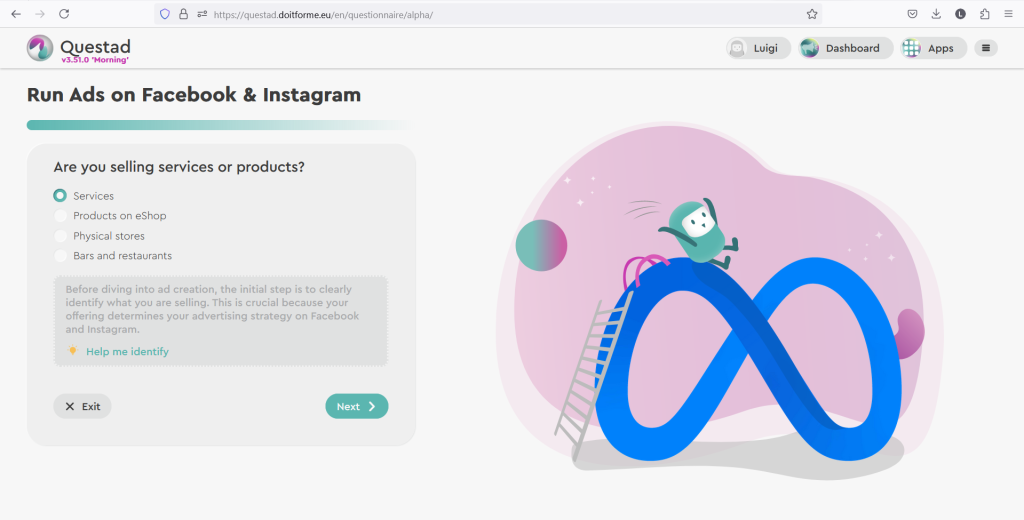
The first step is extremely important as, depending on the user’s choice, our algorithm creates a different target campaign for each case.
Services
In detail, when someone selects services in this step, our algorithm creates campaigns targeting prospective customers. That is, it tries to optimize the available budget to collect the contact information of as many potential customers as possible. This in marketing terminology is also referred to as Lead Generation.
How is prospective customer data collected?
When the user selects this option, in a later step he is invited to create a Landing Page with a contact form, which is linked to his advertisement. Any prospect watching the ad (if they are more interested) can click on the link to the ad. From there, they are taken to the form where, by filling in their details, you are immediately notified by email that you have a prospect.
What is a landing page?
According to https://unbounce.com/landing-page-articles/what-is-a-landing-page/:
A landing page is a standalone website, which is created specifically for a marketing or advertising campaign. It is where a visitor “lands” after clicking on a link.
Unlike websites, which typically have multiple objectives and encourage exploration, landing pages are designed with a single focus or objective, known as a call to action (or CTA, for short).
This focus is what makes landing pages the best choice for increasing conversion rates of marketing campaigns and reducing the cost of acquiring a lead or sale.
The landing page has the PIXEL tracking algorithm built-in as well as the Conversion API.
But what is the PIXEL tracking algorithm and the CONVERSION API that might seem unintelligible?
What is the META PIXEL?
According to https://www.facebook.com/business/tools/meta-pixel:
The Meta Pixel is a piece of code on your website that can help you understand the effectiveness of your ads and the actions that users take on your site, such as visiting a page or adding a product to their cart. You’ll also be able to see when customers took an action after seeing your Facebook and Instagram ad, which can help you with retargeting. Also, when you use the conversion API along with Pixel, the link established is more reliable and helps the display system reduce costs.
What is the CONVERSION API;
Its concept is more complex than the pixel and for those who wish to delve deeper can read more here: https://www.facebook.com/business/help/2041148702652965?id=818859032317965
With the Questad implementation you don’t have to worry because both are embedded by us and you are not required to do any of the embedding. So, you avoid the whole process of creation and integration and you can immediately start collecting prospective customers.
Products through e-shop
When someone in the first step chooses to offer products via e-shop, our algorithm builds a set of Sales and traffic campaigns depending on the available budget, with the aim of increasing sales. Also, using the data from PIXEL it also creates Sales Campaigns on existing audiences creating the Remarketing campaigns.
What are Remarketing or Retargeting campaigns?
According to https://www.outbrain.com/blog/remarketing-guide/
Retargeting – commonly known as Remarketing or Retargeting – is a form of online advertising that can help you retarget users who have visited your site at least once, but without completing any meaningful action.
Physical Shops or Bar & Restaurants
When someone in the first step chooses physical stores or Bar & Restaurants in essence our algorithm creates a set of campaigns aimed at interaction, to create a large enough brand repeatability to new and existing audiences (retargeting).
Step 2: Select Sector
In this step, the user simply enters in free text the object that his business is dealing with. Due to the fact that in our future plans is to create an artificial intelligence system, depending on the data that the user fills in about his domain, our algorithm will suggest future optimizations and suggestions for better performance.
Step 3: Create an account in our application with Email and user password
With their account in our app, a user can monitor the performance of their campaigns, receive notifications of optimization suggestions, as well as modify their campaigns by changing the medium (video, photo and catalogue) as well as the caption, titles, etc. Also, through the management tool, the user can access his prospective clients at any time.
Step 4: Log in to Facebook to connect the app to your Social Media pages
You link to your personal Facebook account and give the app permission to run ads for the business pages linked to your personal account. At this point it is worth noting that it is necessary for anyone running ads through Questad to have a Business Portfolio in META.
What is the Business Portfolio at META?
As officially reported by META here: https://www.facebook.com/business/help/486932075688253
The business portfolios in Meta Business Suite connect your business assets, such as your Facebook Pages, Instagram accounts and other assets, so you can manage these assets and user access to them from the same place.
Step 5: Select the Facebook page you want to advertise on
At this point, if you have Instagram and Facebook linked automatically, your campaigns will run on both Instagram and Facebook with your different accounts on each platform.
If you don’t have your Instagram & Facebook accounts linked you can do it step by step here:
How do I connect Instagram to Facebook?
Step 1: Log in to your Facebook account
Step 2: Go to your business page and click Convert
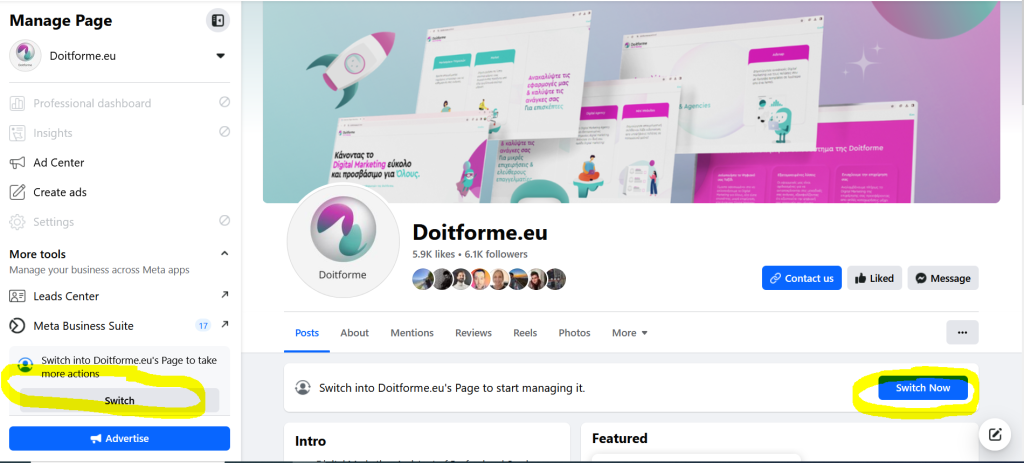
Step 3: Select META BUSINESS SUITE from the left
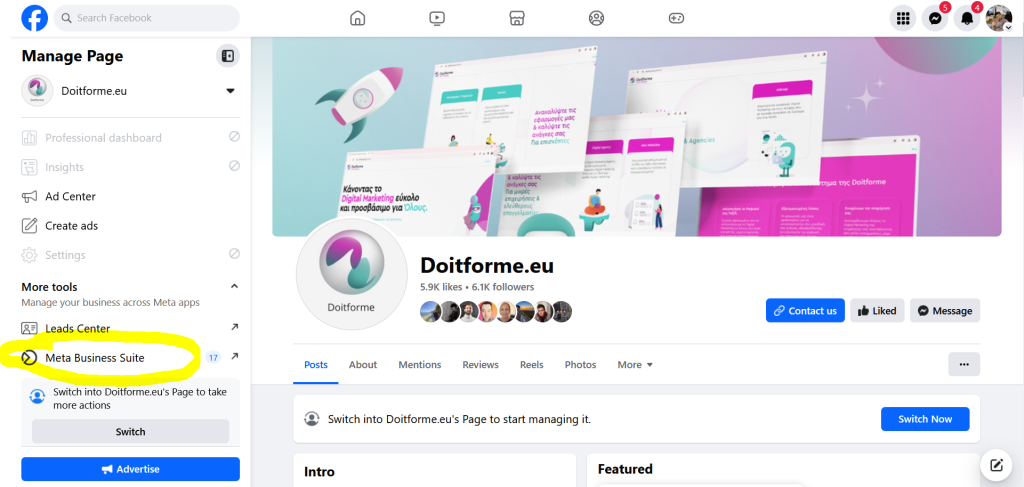
Step 4: Tap Connect to Instagram
- PS: If already connected, it will show you both profile icons together and filled in.
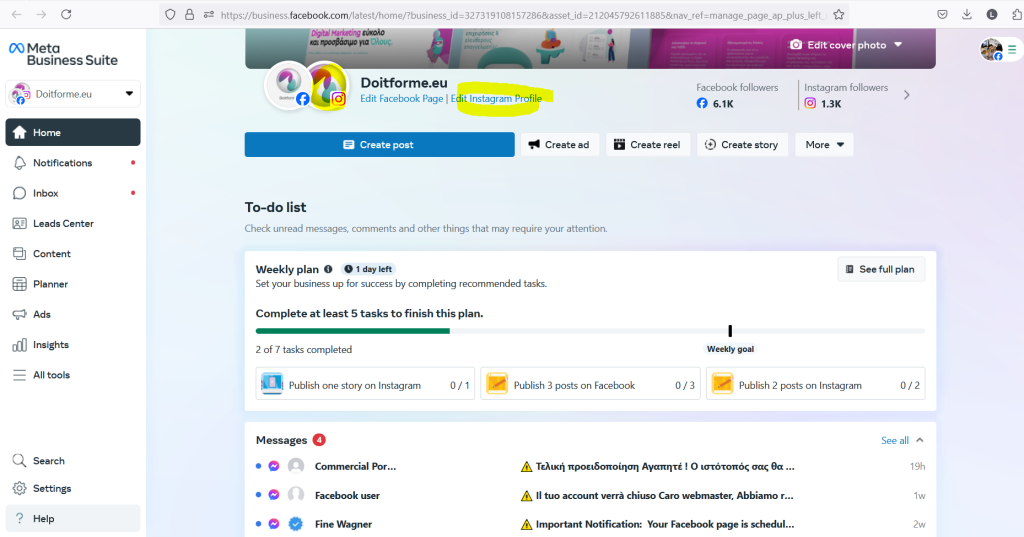
How do I choose which areas to find potential clients in?
In the next step, the application asks the user in which region he or she wants to find potential customers. There, the user is asked to choose the locations wisely. When the user has a low budget, it is better to choose smaller targeting locations in terms of inhabitants. When the user has a larger budget, it is advisable to choose the whole country. META ads on Facebook & Instagram are auction ads. In essence, advertisers compete through auction for the attention of users in the targeted areas. In fact, if you choose Attica for example, you are competing against all the business owners who choose to gain the attention of users in Attica.
Interests of Target Audience
In the next step, the application asks us to fill in some interests that our potential customers may have.
How to choose interests on facebook audience;
Facebook ad targeting interests refer to specific topics, behaviours, activities or preferences that advertisers can choose to define and reach their desired audience on the platform.
These interests are used to target users based on their demonstrated interests, activities, preferences as well as their engagement patterns on Facebook.
Thus, advertisers are able to narrow down their audience to people who are more likely to interact.
Here, it is emphasized that if you are not well aware of the interests your audience may have in META or if they do not appear in the META interest list, it is better to let the algorithm alone find the interests in a general audience.
Also, when the population in an area is minimal it is better not to further limit the audience because it will be so very small that it will not be able to run the campaign efficiently resulting in targeting a minimal number of users, creating high repetitiveness and tiring the creative.
Audience demographic targeting
The next step concerns the targeting demographics. Select your target age groups as well as the gender of your candidates.
In the next step, the user is asked to select the available Budget he/she wants to pay for the whole month. Questad does not allow for optimization purposes for any user to run campaigns for less than a month. The amount the user sets as the budget includes the tool’s commissions as well as taxes. Therefore, the actual advertising value is not the amount the user declares at this stage. For commission charges you can consult the table below, in which you can see that our commission decreases by percentage with the advertising spend:

Creation of advertising
Finally, the user is invited to create his or her advertisement. That is, to choose an image or a video, as well as to write a caption in order to be able to follow the payment and the campaigns, after the approval by META, to be activated.
Creating a Landing Page
In case the user has selected services in the first step, there will be another intermediate step, where he/she is asked to create a Landing Page (as mentioned in detail before)
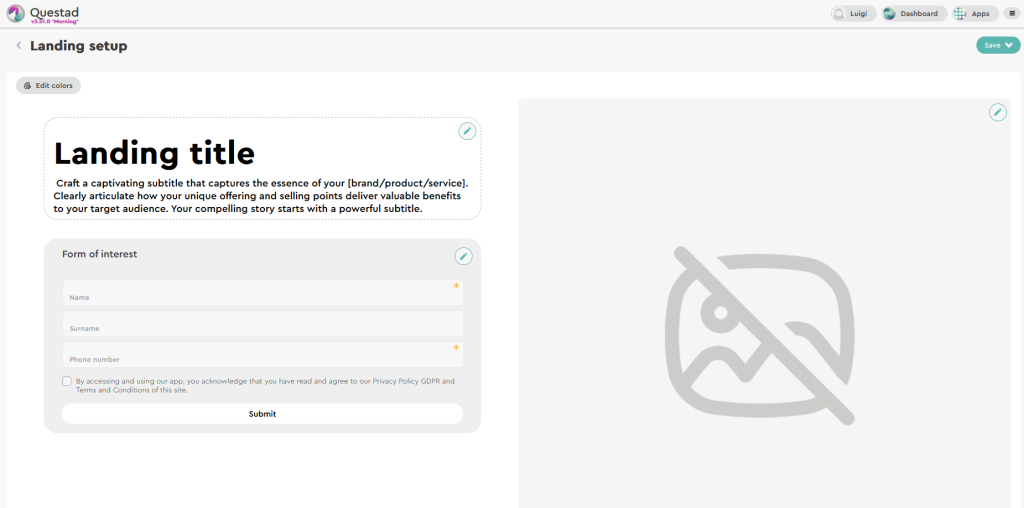
Creating a Product Catalogue Ad
If in the first step you choose ”selling products via e-shop”, we recommend using the META catalogue to create advertising. Thus, we can directly display the catalogue products in Carousel format, even selecting specific sets which you can easily create through META’s Commerce Manager.
